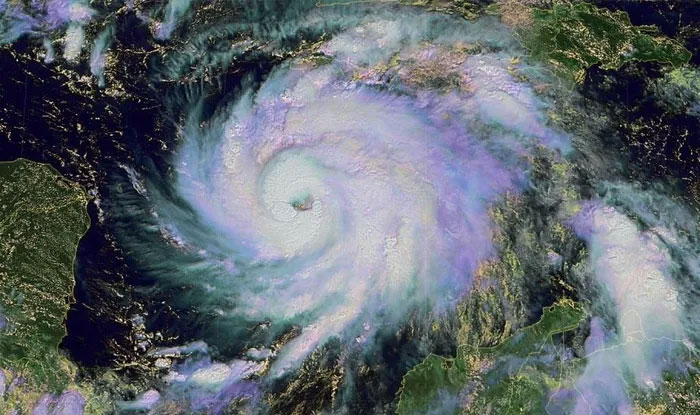Why is the La Nina phenomenon so destructive to the planet?
The transition from El Nino to La Nina creates a form of terrible destruction to people, the environment and ecosystems on Earth. Accordingly, the La Nina phenomenon causes a series of extreme weather phenomena around the globe.
La Nina is a phenomenon in which the surface sea water layer in the Central and Eastern Pacific Ocean at the equator cools abnormally, occurring with a period similar to or less frequent than that of El Nino.
Normally, shortly after El Nino ends, a La Nina will occur, causing more storms in the Atlantic but reducing the risk of hurricanes in the Pacific. La Nina occurs in a cycle every 2-7 years, usually starting from March to June every year and has the strongest effect from the end of the year to February of the following year.
The cause of La Nina phenomenon is due to the sea surface temperature lower than the standard temperature ( standard temperature about 25 degrees Celsius) by 0.5 degrees Celsius or more. This is the opposite of El Niño, which is formed when trade winds in the equatorial region strengthen, bringing cold ocean currents from the depths to the surface of the ocean. This phenomenon has appeared in the Pacific region as the Northern hemisphere prepares to enter the winter months.

La Nina once caused hurricane Mitch - the second largest "killer" in human history in 1998. (Photo: Lolwot)
According to many studies, the transition from El Nino to La Nina creates a terrible devastation to people, the environment and ecosystems on Earth. Accordingly, the La Nina phenomenon causes a series of terrifying extreme weather phenomena across the globe such as floods in spring, record snowfall in winter, drought in summer.
World Meteorological Organization (WMO) Secretary General Petteri Taalas said: "El Nino and La Nina are the main drivers of the Earth's climate system. But every naturally occurring climate event is now set to in the context of anthropogenic climate change, which increases global temperatures, thereby exacerbating weather phenomena, affecting the annual rainy season and complicating forecasting and responding to natural disasters'.
In addition, La Nina can also affect the southwest Indian Ocean tropical cyclone season, reducing its intensity. Southeast Asia, some islands in the Pacific Ocean and northern parts of South America are expected to receive above-average rainfall. In India, La Nina means that the country will receive more rain than usual, leading to flooding.
Not only that, the terrible impact of La Nina also caused global food loss, crop failure, and constant hunger in poor countries in Africa and Asia.
In particular, Africa and Central Asia will have below average rainfall due to the influence of La Nina. WMO warns East Africa will experience drier-than-normal conditions, which, together with the existing effects of a desert locust invasion, could further increase food insecurity in the region.
Historically, the La Nina phenomenon once caused Hurricane Mitch , the second largest "murderer" in human history in 1998, causing a terrifying obsession with people alive to this day. Super Typhoon Mitch formed from the Atlantic Ocean with winds of 290 km/h, a Category 5 hurricane that claimed 22,000 lives and left 22,000 missing, displaced 2.7 million people, and caused property damage up to US$6 billion (1988) in two Central American countries, Nicaragua and Honduras.
La Nina makes winter this year can be colder
The US Center for Climate Prediction predicts that there is a 90% chance that La Nina will exist until February 2022 . In the months of La Nina, temperatures will be lower than usual, prompting meteorological agencies to issue warnings of a severe winter.
Since October, many Asian countries have had unusual cold spells. Korea has just experienced a cold wave, cold air from the North Pole poured in, causing the temperature in many areas to drop sharply to the minus level and frost appeared in the morning of October 17, marking the coldest morning in the middle of the year. October in the past 64 years in the land of kimchi.
Also on October 17, China witnessed freezing temperatures 20 days earlier than the average on November 8. The cold wave pulled the temperature in many places in Hebei, Shandong, Henan, Anhui and Jiangsu provinces down to 10 degrees Celsius within 24 hours, many residents said, it was like a refrigerator's "quick freezing mode" cold.
- What is La Nina phenomenon?
- 'The phenomenon of La Nina will end globally
- La Nina phenomenon continues to last until early 2008
- La Nina weather phenomenon has reached its peak
- WMO: La Nina's weather phenomenon is about to end
- La Nina is coming back
- La Nina may be the cause of a pandemic
- El Nino goes, La Nina comes
- Vietnam may suffer from heavy rain
- El Nino is about to end in the Caribbean
- NASA: We are experiencing the peak of El Nino
- New discovery about the formation of water hoses
 'Fine laughs' - Scary and painful torture in ancient times
'Fine laughs' - Scary and painful torture in ancient times The sequence of numbers 142857 of the Egyptian pyramids is known as the strangest number in the world - Why?
The sequence of numbers 142857 of the Egyptian pyramids is known as the strangest number in the world - Why? History of the iron
History of the iron What is alum?
What is alum?